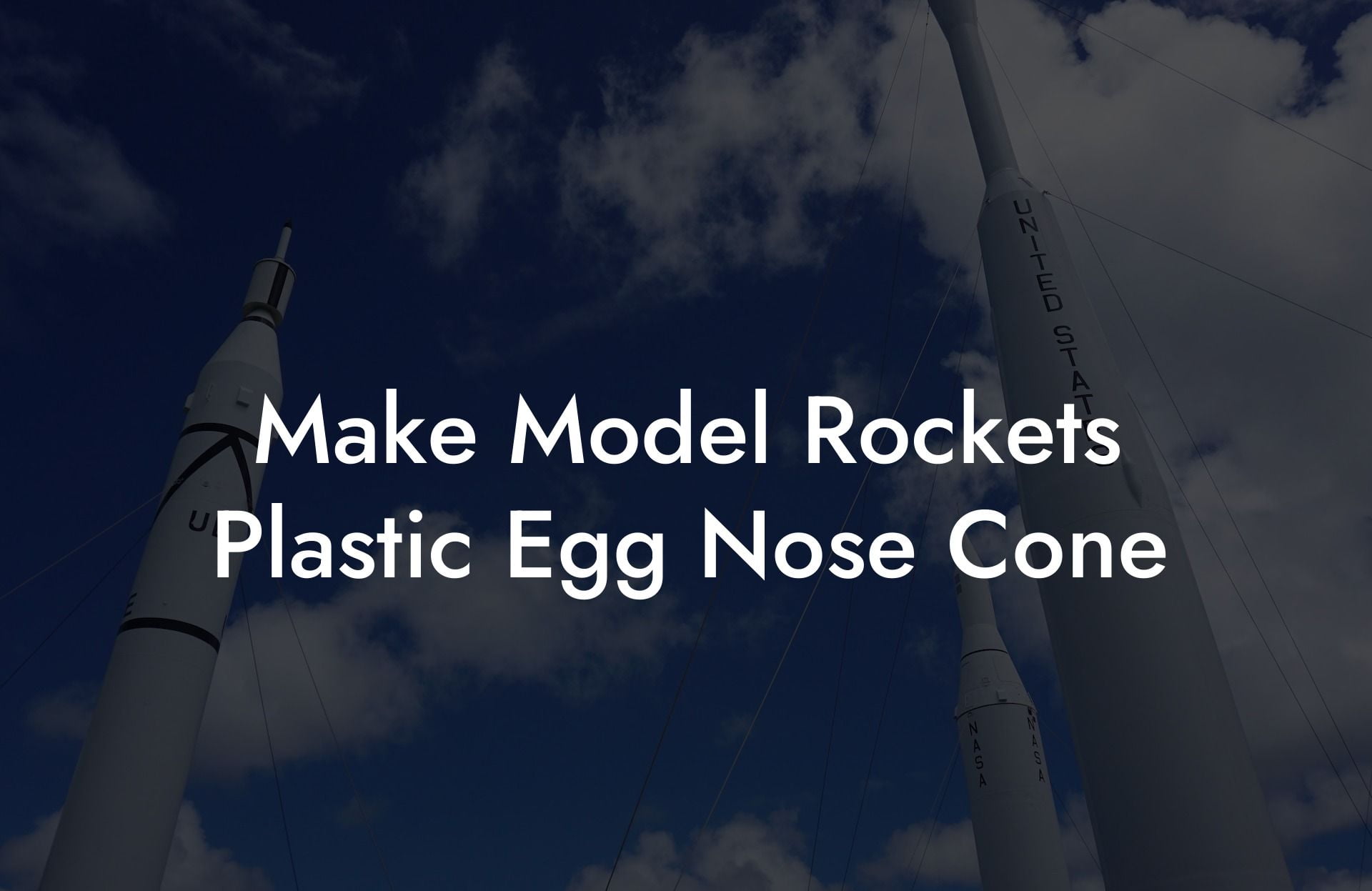Imagine soaring to new heights with your very own model rocket, its plastic egg nose cone gleaming in the sunlight as it pierces the sky. Welcome to the world of model rocketry, where creativity meets innovation and the thrill of flight awaits. Whether you're a seasoned enthusiast or just starting out, this comprehensive guide will walk you through the art of crafting a plastic egg nose cone, the perfect addition to your model rocket.
Quick Links to Useful Sections
- What is a Plastic Egg Nose Cone, and Why Do I Need One?
- The Benefits of Using a Plastic Egg Nose Cone
- Materials and Tools Needed
- Step-by-Step Guide to Crafting a Plastic Egg Nose Cone
- Tips and Tricks for Customizing Your Plastic Egg Nose Cone
- Frequently Asked Questions
- Resources and community Support: Your Next Steps
What is a Plastic Egg Nose Cone, and Why Do I Need One?
A nose cone is a critical component of any model rocket, serving as the forward-most point of the vehicle. Its primary function is to reduce air resistance, allowing your rocket to cut through the atmosphere with ease. A plastic egg nose cone, in particular, offers a unique blend of durability, lightness, and aerodynamic efficiency.
By crafting a plastic egg nose cone, you'll not only enhance your model rocket's performance but also add a touch of personality to its design. With a wide range of customization options available, you can let your creativity shine and make your rocket truly one-of-a-kind.
The Benefits of Using a Plastic Egg Nose Cone
So, why choose a plastic egg nose cone over other materials? Here are just a few advantages that set it apart:
- Lightweight and Durable: Plastic egg nose cones are incredibly light, which helps to reduce the overall weight of your model rocket and improve its flight performance. At the same time, they're surprisingly durable, withstanding the stresses of launch and recovery.
- Aerodynamic Efficiency: The smooth, curved surface of a plastic egg nose cone helps to reduce air resistance, allowing your rocket to cut through the atmosphere with ease and achieve greater heights.
- Customization Options: With a plastic egg nose cone, you can unleash your creativity and add a personal touch to your model rocket's design. From bold colors to intricate patterns, the possibilities are endless.
- Cost-Effective: Compared to other materials, plastic egg nose cones are relatively inexpensive, making them an excellent choice for model rocket enthusiasts on a budget.
Materials and Tools Needed
Before you begin crafting your plastic egg nose cone, make sure you have the following materials and tools at your disposal:
Looking For The Best Model Rocket Kits? You'll Love These:
- Plastic eggs (available at most craft stores)
- Sandpaper or a Dremel tool
- Glue (such as epoxy or hot glue)
- Paint and primer (optional)
- A drill press or hand drill
- A model rocket body tube (to ensure a proper fit)
Step-by-Step Guide to Crafting a Plastic Egg Nose Cone
With your materials and tools ready, it's time to start crafting your plastic egg nose cone. Follow these steps to achieve a professional-looking finish:
- Begin by cleaning and preparing the plastic egg. Use sandpaper or a Dremel tool to smooth out any rough edges or bumps.
- Next, apply a coat of primer to the egg, followed by a layer of paint (if desired). This will help to enhance the nose cone's appearance and provide additional protection.
- Once the paint is dry, use glue to attach the nose cone to the model rocket body tube. Make sure the fit is secure and even.
- Use a drill press or hand drill to create a small hole at the tip of the nose cone, allowing for the attachment of a recovery system (such as a parachute or streamer).
- Finally, inspect your nose cone for any imperfections or rough edges. Sand or file these areas to achieve a smooth, aerodynamic finish.
Tips and Tricks for Customizing Your Plastic Egg Nose Cone
Want to take your plastic egg nose cone to the next level? Here are some expert tips and tricks to help you customize your design:
- Experiment with Colors: Use bold, vibrant colors to add visual interest to your nose cone. You can also try layering different colors or using metallic paints for a unique effect.
- Add Decals or Markings: Use decals or paint to add markings, logos, or other designs to your nose cone. This is a great way to personalize your model rocket and make it stand out.
- Try Different Shapes: Don't be limited to a traditional egg shape! Experiment with different shapes, such as a cone or a teardrop, to create a truly unique nose cone.
- Add a Clear Coat: Apply a clear coat to your nose cone to protect the paint and give it a glossy finish.
Frequently Asked Questions
Got questions about crafting a plastic egg nose cone? Here are some answers to common queries:
1. What type of plastic eggs work best for nose cones?
Any type of plastic egg can be used, but thicker, more durable eggs tend to work best. Look for eggs specifically designed for craft projects or model rocketry.
2. How do I ensure a secure fit between the nose cone and body tube?
Use a combination of glue and friction to secure the nose cone to the body tube. Make sure the fit is snug and even, with no gaps or loose areas.
3. Can I use a plastic egg nose cone on a high-powered model rocket?
While plastic egg nose cones are durable, they may not be suitable for high-powered model rockets. In these cases, it's recommended to use a more robust material, such as fiberglass or aluminum.
Resources and community Support: Your Next Steps
Congratulations on completing your plastic egg nose cone! Now, it's time to take your model rocketry skills to the next level. Here are some resources and community support options to help you on your journey:
- Model Rocketry Forums: Join online forums and discussion groups dedicated to model rocketry, where you can connect with other enthusiasts, share tips, and learn from experts.
- Local Model Rocketry Clubs: Look for local clubs or organizations in your area, where you can meet fellow model rocket enthusiasts, attend launches, and participate in workshops.
- Online Tutorials and Guides: Explore online resources, such as YouTube tutorials and step-by-step guides, to learn new skills and stay up-to-date with the latest model rocketry techniques.
Remember, the world of model rocketry is all about experimentation, creativity, and community. Don't be afraid to try new things, ask questions, and share your experiences with others.
Looking For The Best Model Rocket Kits? You'll Love These:
Useful Interruption: Dive deeper into the world of Model Rockets with our most popular sections. If there is anything you think is missing or anything you would love for us to write about, just give us a shout.
- Getting Started & Basics With Model Rockets
- Model Rocket Design, Build & Customization
- Model Rocket Propulsion & Engine Technology
- Model Rocket Launch Techniques & Recovery
- Model Rocket Advanced Rocketry & Innovations
- Model Rocket DIY and Customization
- Model Rocket Equipment Reviews & Digital Tools
- Community, Competitions & Education
- Model Rocket Troubleshooting & FAQs
- Model Rocket Bonus/Seasonal & Niche Topics
A group of model rocket enthusiasts gathered at a field for their weekly launch event. Among them was Dave, a seasoned builder known for pushing the limits of hobby rocketry. This time, he had outdone himself.
“Ladies and gentlemen,” Dave announced, dramatically pulling a cloth off his latest creation, “I present to you: The Kraken!”
The crowd gasped. This wasn’t just a model rocket, it was a monster. The thing stood 8 feet tall, had six clustered engines, and was covered in enough duct tape to qualify as a classified aerospace project.
“Dave,” muttered Steve, the cautious safety officer, “Have you, uh… done the math on this?”
“Math?” Dave scoffed. “I built it in my garage at 3 a.m. with parts from eBay. This is an art piece, Steve.”
The countdown began.
5…
4…
3…
2…
1…
The engines ignited with a BOOM, and The Kraken shot up… kind of. It immediately did a violent barrel roll, narrowly missing the spectators before skyrocketing at an angle that could only be described as “legally questionable.”
The crowd collectively ducked as The Kraken flew straight over the adjacent cornfield, where Old Man Jenkins, the grumpiest farmer in town, was minding his business.
KABOOM!
The rocket disappeared behind the barn. A moment later, a flaming piece of Estes igniter wire landed at Steve’s feet. The silence was deafening.
And then, an unmistakable sound echoed across the field.
Jenkins’ shotgun being cocked.
“DAVE!!!” Steve shouted. “RUN.”
And that was the day Dave invented the first-ever biologically powered rocket booster: pure adrenaline.
To this day, nobody knows where The Kraken landed, but legend has it, it still haunts the skies, terrifying unsuspecting drones and low-flying birds.















